
The Hamilton H-45 and H-47 were six-passenger-seat, all-metal, high-wing monoplanes powered by single Pratt & Whitney radial engines. They were built for passenger and mail-carrying work in the US in the late 1920s.
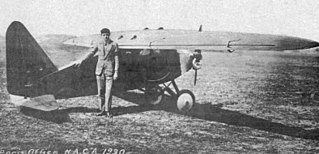
The Peyret-Mauboussin PM X, PM 4 or Mauboussin M.10 was a low power, single-seat, high wing cantilever monoplane. Only one was built but it set several records in the under 250 kg (550 lb) class both as a landplane and a floatplane.
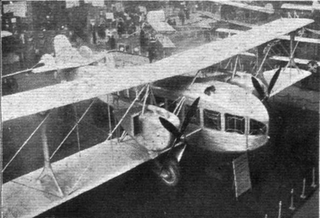
The Bréguet Leviathan was a family of large all-metal biplane aircraft built in France in the early 1920s. The Bréguet XX and XXI were notable for being powered by Bréguet-Bugatti multiple engines, in two forms. The Bréguet XXI was powered by individual Bréguet-Bugatti U.16 engines initially and Lorraine-Dietrich 8b engines in tandem later. The Bréguet XXII had accommodation for about twenty passengers and was destroyed during a 1923 transport aircraft competition. Development of all three aircraft types was halted largely due to technical issues with power-plants and aircraft structure.

The Potez VIII was a French training aircraft which first flew in 1920. Originally it had a very unusual vertical inline engine and a four-wheeled undercarriage, though the production version was more conventional.
The Potez 27 was a French reconnaissance biplane first flown in 1924. 175 were operated by the Polish Air Force, most built in Poland by PWS under licence. Others went to Romania, where they were also used as light bombers.

The Caudron C.27 was a French biplane, a two-seat basic trainer which also competed successfully in the 1920s.
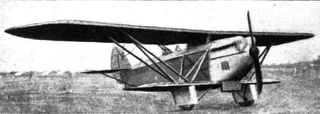
The Descamps 17 A.2 was a two-seat reconnaissance fighter built under a French government programme of 1923. Two versions, with different engines, were tested and six examples were built under licence by Caudron as the Caudron C.17 A.2.

The de Marçay Passe-Partout was a small, low-powered single-seat sport and touring aircraft built in France just after World War I.

The Albessard Triavion, sometimes known as the Peyret-Albessard Triavion, was a three surface aircraft, combining a tandem wing and conventional tailplane.

The Les Mureaux 3 C.2 and Les Mureaux 4 C.2 were French two seat, parasol winged fighters, flown in 1927-8, which differed only in their engines. They were developed into near identical army co-operation types, the ANF Les Mureaux 130 A.2 and ANF Les Mureaux 131 A.2, in 1929-31.

The SFCA Maillet 20 was a French three seat tourer built in 1935. The Armée de l'Air ordered 30 for training and liaison and several were raced. The aircraft was developed through 1935 via cockpit layout and canopy changes to the provision of retracting landing gear.

The Delanne 11 was a French two seat touring aircraft. Only one was built.
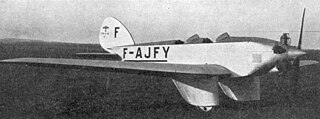
The Albert A-60 was a single engine, two seat, wooden sports monoplane designed and built in France in the early 1930s. Two were built and flown with three different engines.

The Wibault 260 R.2 was a contender for a French government contract for a long range, two seat reconnaissance aircraft, issued in 1928. There were eight prototypes in the 1931-2 contest and the Wibault was not selected for production.
The Morane-Saulnier MS.300 and MS.301 were French parasol wing introductory trainer aircraft, first flown in 1930. They differed only in engine type. Neither reached production but were developed into two similar trainers, the MS.230 and MS.315, which were made in large numbers.
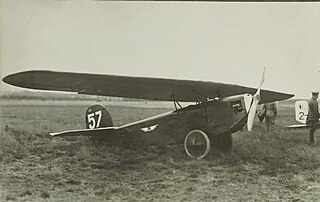
The Udet U 7 Kolibri (Hummingbird) was a single engine, single seat, parasol wing light aircraft, designed and built in Germany in the mid-1920s. Though they had some competition success and set an unofficial lightplane duration record, only two were produced.

The Charmier-Dupuy 10 was a French parasol-winged single seat light aircraft designed for low-cost flying. The sole example was first flown in 1924. Over a long career, it was fitted with three different engines and remained on the French register until after World War II.

The Peyret-Nessler Libellule (Dragonfly) was a French two-seat, low-powered parasol wing light aircraft built in 1927 to provide practical but economical flying. It was one of the first of these French avionettes.

The Guerchais-Henriot T-2 was a French low-power, two-seat cabin cantilever monoplane built in 1928. Only one was flown.

The Bourgois-Sénémaud AT was a parasol wing, two seat touring aircraft built in France in 1928. Three examples were completed.




















